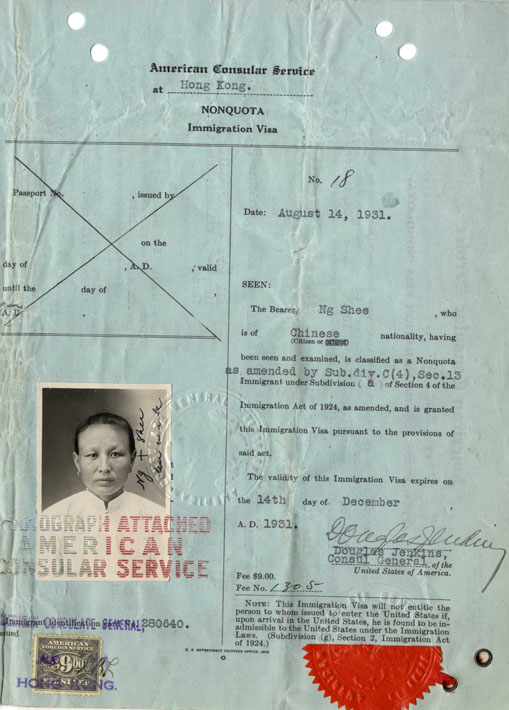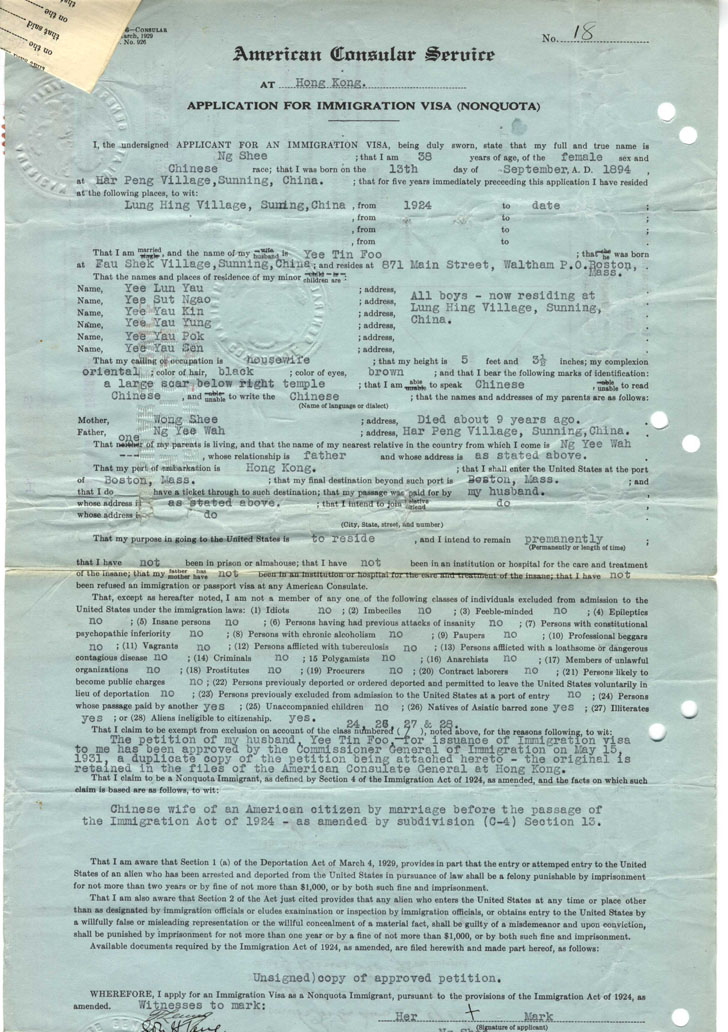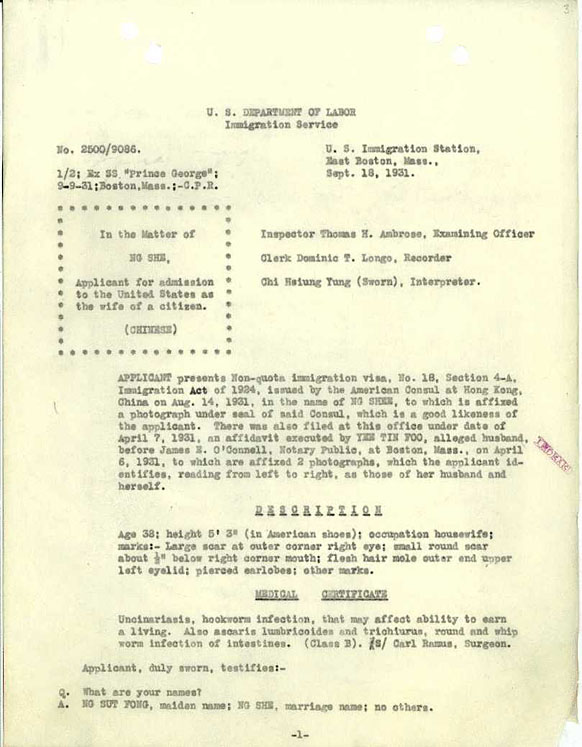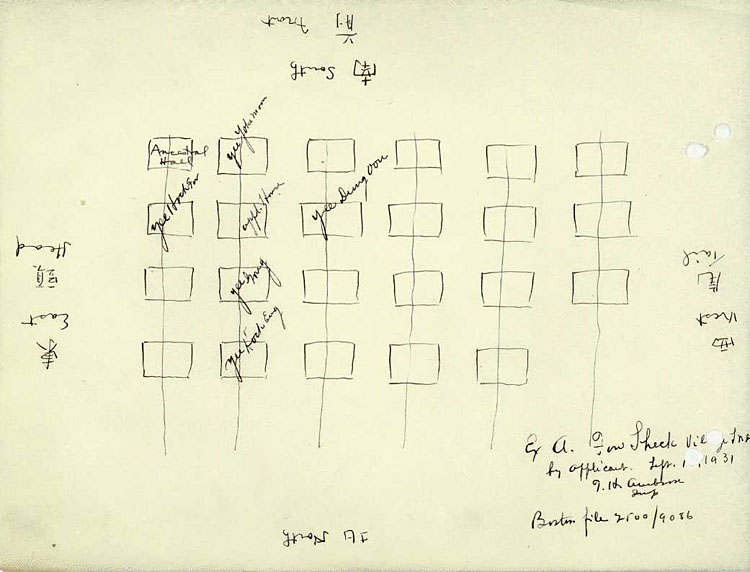
Our Documented Rights: Thinking about Chinese Exclusion
- Documents
- Historical Background
- Activities: Examine it! Use it!
- Broadening Activities
- Additional Resources
- Standards
Documents
Historical Background
An Act to execute certain treaty stipulations relating to Chinese.
Whereas in the opinion of the Government of the United States the coming of Chinese laborers to this country endangers the good order of certain localities within the territory thereof: Therefore, Be it enacted by the Senate and House of Representatives of the United States of America in Congress assembled, That from and after the expiration of ninety days next after the passage of this act, and until the expiration of ten years next after the passage of this act, the coming of Chinese laborers to the United States be, and the same is hereby, suspended; and during such suspension it shall not be lawful for any Chinese laborer to come, or having so come after the expiration of said ninety days to remain within the United States.
- An act to execute certain treaty stipulations relating to the Chinese, May 6, 1882; Enrolled Acts and Resolutions of Congress, 1789-1996; General Records of the United States Government; Record Group 11; National Archives.
- Amended by Sub. Division C(4) of Sec. 13 of the Immigration Act of 1924.
From 1882 to 1943 the United States Government severely curtailed immigration from China to the United States. This Federal policy resulted from concern over the large numbers of Chinese immigrants, competition with American workers and a growing nativism. As a result, an act (22 Stat.58) was enacted on May 6, 1882 to suspend immigration of Chinese laborers for ten years; permitted those Chinese in the United States as of November 17, 1880, to stay, travel abroad, and return; prohibited the naturalization of Chinese; and created a "Section 6" exempt status for teachers, students, merchants, and travelers.
See http://www.archives.gov/publications/prologue/2004/spring/alleged-wife-1.html
Document Background
This Immigration Visa is part of a series of documents in the National Archives at Boston that was used to authenticate the identity of Ng Shee. She was requesting to leave Hong Kong, China, to join her Chinese American husband living in Waltham, MA. The documents include this Nonquota Immigration Visa, her husband's petition requesting that she be allowed to enter the United States, and the map that Ng Shee drew of her village under interrogation by the immigration official(s) with a Chinese interpreter, and the interrogation questions.
Documents such as these are typical of the approximately 25,000 files in the National Archives at Boston pertaining to Chinese exclusion. The purpose of the documents was to ensure that people seeking to immigrate to the United States adhered to the immigration regulations of the times as amended by Sub. Division C(4) of Section 13 of the Immigration Act of 1924.
The end of the story: Ng Shee would be allowed to stay in the United States. In 1966, her sons were investigated to determine if they were actual sons or illegal "paper" sons.
Learning Activities
Examine it!
- 1. Look up the vocabulary related to this document and create a list with the words and definitions: consular, nonquota, immigration, visa, nationality, validity, expires, inadmissible, Hong Kong, Consul General
- The document is dated August 14, 1931. Until what date is this visit valid? How long will Ng Shee be allowed to stay in the US?
- What can we determine visually about Ng Shee from the photograph?
- What two indications of evidence on the document relate the fee paid to process this visa?
- Ng Shee, through this sworn statement, relates being born in China in 1894 and desires to enter the United States through Boston, MA, to live permanently with her husband Yee Tin Foo in Waltham, MA. For what reason does she claim to be eligible for a Nonquota Immigrant Visa?
Collect Needed Knowledge of the Time and Place
- Examine a world map to locate China, Hong Kong, the United States, California, San Francisco, Massachusetts, and Boston. (Waltham is a city 15 miles west of Boston.) Using a map or the internet, calculate the distance from Hong Kong to Boston. Identify some routes one might travel from China to Boston.
- Read a picture book about Chinese immigration and exclusion. Landed by Milly Lee relates the experiences of a Chinese child preparing to enter the United States. Interrogation was believed necessary to prevent the entrance of "paper sons," that is, illegal individuals, into the United States.
- Create a timeline of laws relating to Chinese immigration using the background information presented at
http://www.archives.gov/pacific/education/curriculum/4th-grade/chinese-exclusion.html
Use it!
- Form groups of 3-5 students. Using magnifying lenses, examine the records of case file 2500/9086 the interrogation of Ng Shee, and report what they have discovered and the stories therein.
- Create a biography of Ng Shee based on these documents.
- Using your knowledge of the Chinese Exclusion Act, write an explanation from the point of view of an American legislator why these specific laws were needed and approved in the United States.
- Read the transcript of Soo Hoo Lem Kong's interview to enter the United States at http://www.archives.gov/education/lessons/chinese-exclusion/chinese-exclusion-shlk.html.
In a paragraph, explain how the questions and answers on Soo Hoo Lem Kong's testimony compare to those of Ng Shee.
Broadening Activities
- Try to understand the experience of an immigrant by interviewing someone who has immigrated to the United States. You might use some of these questions:
- Where were you born? How old were you when you came to the United States?
- What are your earliest memories of your home country? Of the US?
- Why did you leave? Why did you come here?
- Tell some stories about your original country and about being an immigrant.
- Do you have advice to help people understand the immigration experience?
- Debate an issue: How should the federal government establish rules about immigration while also protecting the rights of its citizens? How do we make sure that we are open and welcoming to people in our country who may seem different from us?
- Discuss, debate, and/or write about how fair or unfair Chinese Exclusion was. Support both sides of the argument.
- Examine newspapers and other news sources about immigration issues. Find current events that show how we are still defining and evolving our national relationships with those who wish to immigrate to the US.
- Create an illustrated diagram of your neighborhood or school, like that a Chinese immigrant would have had to master prior to his or her arrival in the United States. Include compass directions.
Additional Resources
- Search for Chinese Immigration sources at the National Archives at http://www.archives.gov/research/chinese-americans/
- Review Chinese Immigration and Chinese in the United States: Records in the Regional Archives of the National Archives and Records Administration Reference Information Paper 99, Compiled by Waverly Lowell. Available online at: http://www.archives.gov/research/chinese-americans/guide.html
- Read a picture book about Chinese immigration and exclusion. One suggested reading would be Landed by Milly Lee.
- Use the background and activities from http://www.archives.gov/pacific/education/curriculum/4th-grade/chinese-exclusion.html
- Examine the actual Chinese Exclusion Act (1882). http://www.ourdocuments.gov/doc.php?flash=true&doc=47
National History Standards
Grades K-4
- K-4 Content Standards - Topic Three: Standard 5A - The causes and nature of various movements of large groups of people into and within the United States, now, and long ago.
- Draw upon data charts, historical maps, nonfiction and fiction accounts, and interviews in order to describe "through their eyes" the experience of immigrant groups. Include information such as where they came from and why they left, travel experiences, ports of entry and immigration screening, and the opportunities and obstacles they encountered when they arrived in America.
- K-4 Content Standards - Topic Four: Standard 7A - The student understands the cultures and historical developments of selected societies in such places as Africa, the Americas, Asia, and Europe.
- Describe life in urban areas and communities of various cultures of the world at various times in their history. [Obtain historical data]
Grades 5-12
- A. Era 6 The Development of the Industrial United States (1870-1900) - Standard 2 - Massive immigration after 1870 and how new social patterns, conflicts, and ideas of national unity developed amid growing cultural diversity.
- The student understands the sources and experiences of the new immigrants; s/he assesses the challenges, opportunities, and contributions of different immigrant groups.
- The student can demonstrate understanding of the sources and experiences of the new immigrants



